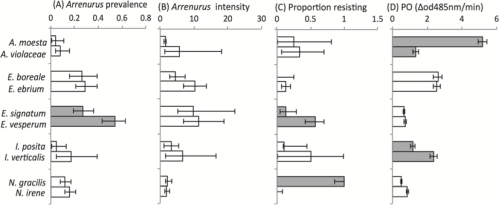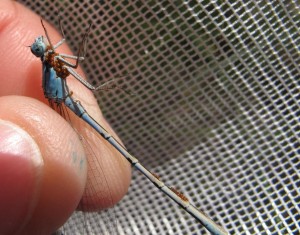This is it! All my PhD thesis chapters have now been published. This last chapter was published in PLOS ONE co-authored by Arne Iserbyt, Laura Nagel and Mark Forbes. It’s closely related to a paper that is in Ecological Parasitology and Immunology (Nagel et al 2014). I consider them sister papers, one spearheaded by Laura Nagel and the other by myself. Both have a similar question: can we compare natural parasitism levels, resistance levels and proxies of immunity. The main differences were that we used different taxa: Mlynarek et al (2015) used Coenagrionid damselflies and Nagel et al (2014) used Lestid damselflies. Additionally, Mlynarek et al (2015) used phenoloxidase (PO) activity as a proxy of immunity whereas Nagel et al (2014) used phenoloxidase activity and encapsulation response to nylon inserts. Lestid damselflies. Because the results were similar, I’ll discuss them together.
First I want to introduce each of the characters were compared and how we defined them.
Natural parasitism is the prevalence (number of host individuals of a species infected by at least one parasite) or intensity (average number of water mite individuals per infected individuals) of water mite parasites (Fig 1). Water mite parasitism is observed by meticulously looking over each damselfly individual collected to determine whether it has any globe-shaped entities and how many there are.
Resistance was defined as the number of host individuals that killed (starved) at least one of the water mite parasites. The water mite damselfly system is ideal to document resistance because starved water mites remain attached to the hosts (Fig. 2).
Phenoloxidase (PO) activity is one of the proxies of innate immunity in insects and is constitutive measure of immunity. Without going into too much detail the enzyme phenoloxidase is the last and key in a chain of prophenoloxidase reaction, which leads to the production of melanin.
Encapsulation response of nylon inserts is an induced response by hosts to ‘parasites’. This proxy is measured as the amount of melanin deposited on a synthetic object that was inserted into the host.
Our results show that when comparing natural parasitism, resistance and innate immunity proxies in four Lestid species and in 10 coenagrionid damselfly species (grouped into species pairs based on generic assignment), the host species with the highest levels of phenoloxidase and depositing the highest amount of melanin on nylon inserts were not the ones with highest prevalence or intensity of natural parasitism or of resistance.
In the coenagrionids, PO activity was different between species in to species pairs (Argia and Ischnura) but those species did not show differences in natural parasitism or resistance (Fig 3). In one species pair, Nehalennia gracilis resists all the water mites but none of the Nehalennia irene resist (we explored the evolution of this resistance in another paper – Mlynarek et al 2014). Finally in Enallagma subgenus Chromatallagma, Enallagma vesperum showed higher levels of natural parasitism and of resistance.

Fig 3. Bar graph comparing measures of parasitism, resistance and PO activity (copied from Mlynarek et al 2015 PLoS One)
I think both of these papers are worth a read (it’s not only because I was involved in writing them).
References
Mlynarek, JJ, Knee W, Forbes MR (2014) Explaining Susceptibility and Resistance to a Multi-Host Parasite. Evol Biol (2014) 41:115–122 DOI 10.1007/s11692-013-9251-6
Mlynarek JJ, Iserbyt A, Nagel L, Forbes MR (2015) Differential Water Mite Parasitism, Phenoloxidase Activity, and Resistance to Mites Are Unrelated across Pairs of Related Damselfly Species. PLoS ONE 10(2): e0115539. doi:10.1371/journal. pone.0115539
Nagel L, Mlynarek JJ, Forbes MR (2014) Comparing Natural Parasitism and Resistance with Proxies of Host Immune Response in Lestid Damselflies. Ecological Parasitology and Immunology Vol. 3 (2014), doi:10.4303/epi/235884


